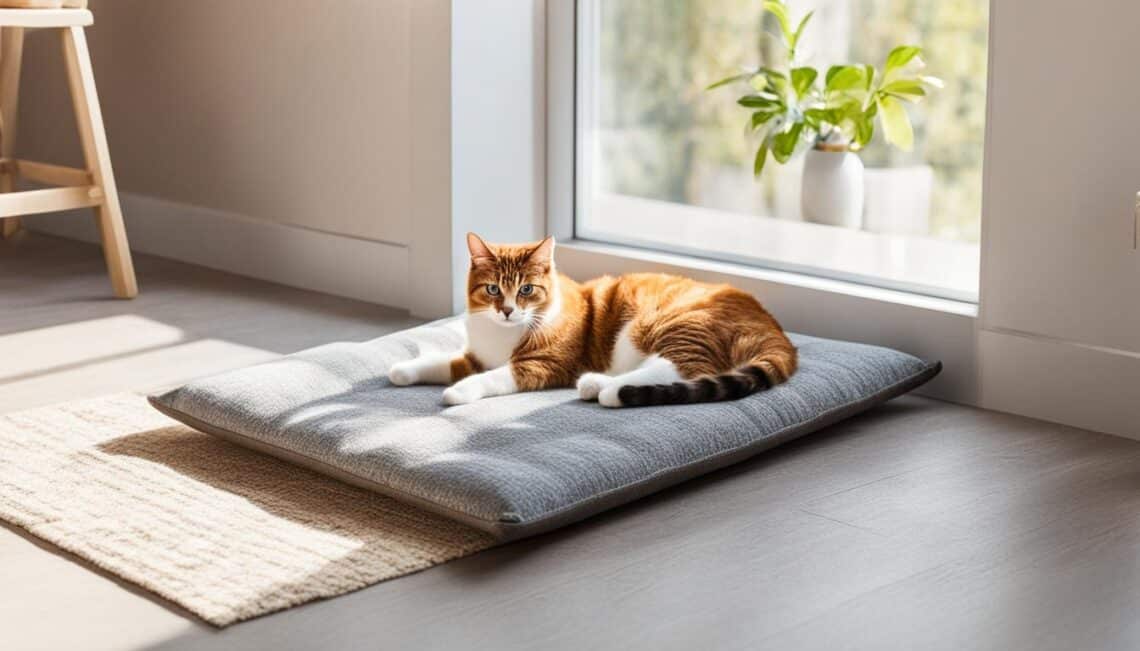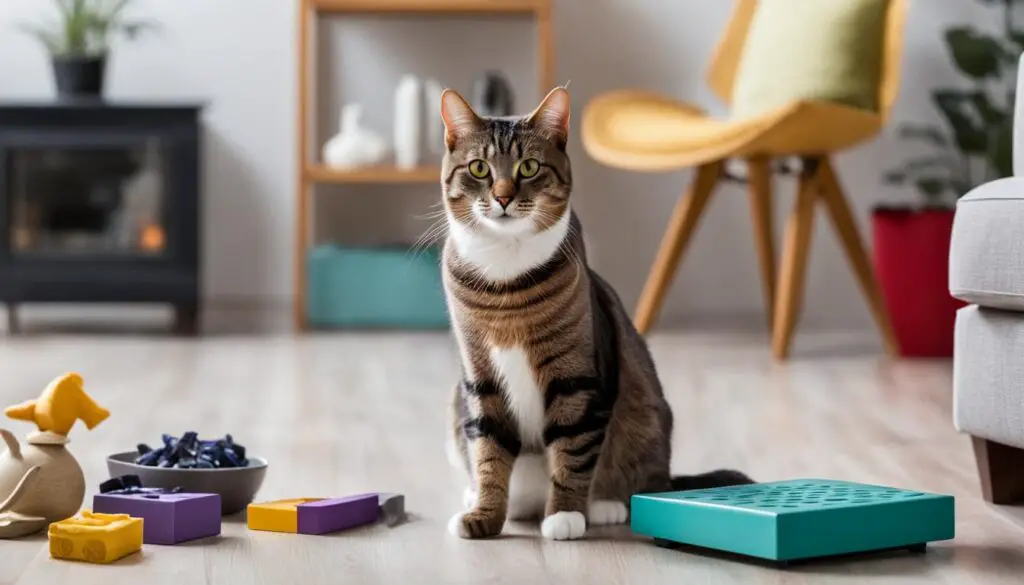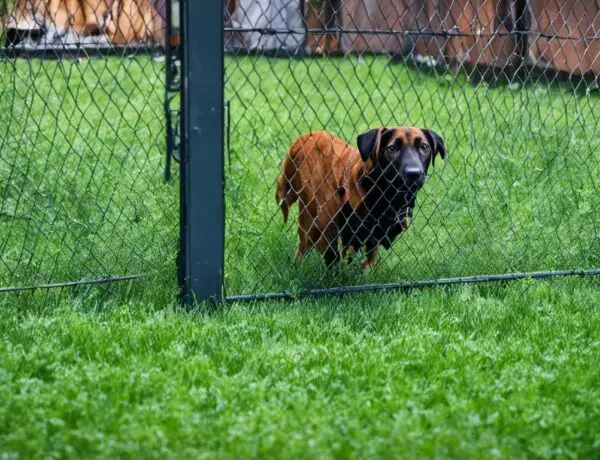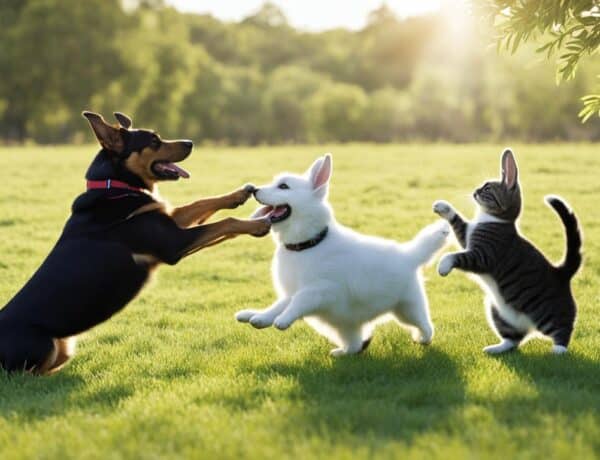I, as a cat lover, understand the importance of building a harmonious relationship with my indoor cat. Cats have unique personalities and behaviors that require understanding and patience. To create a happy and well-behaved feline companion, essential training for indoor cats is crucial.
Key Takeaways:
- Understanding your indoor cat’s needs and behaviors is essential for successful training.
- Positive reinforcement training techniques, like rewarding desired behaviors, are highly effective.
- Teaching your cat basic commands and socializing them is important for clear communication.
- Environmental enrichment and mental stimulation play a significant role in keeping your indoor cat happy.
- Building a harmonious relationship with your indoor cat requires patience, consistency, and understanding.
Understanding Your Cat’s Needs and Behaviors
Cats are fascinating creatures with their own unique set of needs and behaviors. To effectively train your indoor cat and foster a harmonious relationship, it is essential to understand and respect their individual personalities.
Rest and Comfort: Cats require adequate rest and a sense of comfort in their environment. Provide them with cozy beds or blankets, as well as secluded spots where they can retreat and relax.
Playtime: Engaging in play sessions with your cat is crucial for their mental and physical well-being. Interactive toys that mimic prey can stimulate their natural instincts and provide much-needed exercise.
Safe Space: Cats need a safe and secure environment where they can feel protected. Ensure that your home has areas or rooms where your cat can retreat to when they need some alone time.
Scratching Instinct: Cats have a natural instinct to scratch, which helps them maintain their claws and mark their territory. Redirect this behavior by providing appropriate scratching posts or mats to protect your furniture and carpets.
By understanding and addressing your cat’s specific needs and behaviors, you can create a supportive and enriching environment for effective training and a harmonious relationship.
| Behavior | Description |
|---|---|
| Playful behavior | Cats engage in playful activities to keep themselves mentally and physically stimulated. |
| Grooming behavior | Cats spend a significant amount of time grooming themselves to keep their fur clean and healthy. |
| Scratching behavior | Cats scratch to mark their territory, stretch their muscles, and maintain their claws. |
| Hunting behavior | Cats have an innate hunting instinct and may display behaviors like stalking, pouncing, and capturing toys or prey. |
| Sleeping behavior | Cats sleep for long hours throughout the day, taking short and frequent naps to conserve energy. |
“Understanding your cat’s needs and behaviors is the foundation for successful training and building a strong bond with your feline companion.” – Dr. Sarah Johnson, Feline Behavior Specialist
Providing for Your Cat’s Needs
Creating a conducive environment for your cat can significantly contribute to their overall well-being. Consider the following tips:
- Offer a variety of toys and interactive games to keep your cat mentally stimulated.
- Provide scratching posts or mats in multiple locations to satisfy their scratching instinct.
- Dedicate areas in your home for vertical climbing, like cat trees or shelves, to fulfill their natural need to climb and explore.
- Ensure easy access to food, water, and litter boxes in separate areas to promote good hygiene and reduce stress.
- Establish a regular routine for playtime, feeding, and bonding to create a sense of security and familiarity for your cat.
By meeting your cat’s needs and understanding their behaviors, you can lay the foundation for successful training and nurture a loving and harmonious relationship.
Positive Reinforcement Training Techniques
In order to effectively train your indoor cat, it is essential to utilize positive reinforcement techniques. This training method focuses on rewarding desired behaviors to encourage their repetition. By using treats, praise, or playtime as rewards, you can create a positive association with training for your feline friend.
Consistency is key when implementing positive reinforcement. It is important to reinforce desired behaviors consistently, as this helps your cat understand what is expected of them. By providing consistent rewards for their good behavior, you can reinforce positive habits and discourage undesirable ones.
When using positive reinforcement, remember to be patient and avoid punishment-based techniques. Instead of scolding or punishing your cat for undesired behaviors, redirect their attention towards behaviors that you want to encourage. By rewarding them when they exhibit the desired behaviors, you can help them learn and respond positively to your training efforts.
“Using positive reinforcement in training can make the learning process more enjoyable for both you and your cat. It creates a bond of trust and encourages a cooperative attitude.”
Positive reinforcement training can be applied to a wide range of behaviors, including litter box use, scratching the appropriate surfaces, and coming when called. By breaking down the training process into small steps and rewarding your cat’s progress, you can gradually shape their behavior and reinforce positive habits.
Examples of Positive Reinforcement Training Techniques
- Clicker Training: Use a clicker to mark desired behaviors, followed by a reward. This helps your cat associate the sound of the clicker with a reward, making the training process more effective.
- Treat Rewards: Use small, tasty treats as rewards for desired behaviors. This can include sitting on command, using the litter box, or walking on a leash.
- Playtime Rewards: Use interactive play sessions as rewards for your cat’s good behavior. This can help release excess energy and strengthen the bond between you and your furry companion.
By implementing positive reinforcement training techniques, you can create a positive and cooperative training environment for your indoor cat. Remember to be patient, consistent, and reward your cat’s progress to ensure a successful training experience.
| Benefits of Positive Reinforcement Training |
|---|
| Strengthens the bond between you and your cat |
| Encourages desired behaviors |
| Creates a positive association with training |
| Fosters a cooperative attitude |
| Reduces stress and fear in your cat |
Basic Commands and Socialization
Teaching your indoor cat basic commands is an essential part of their training. Not only does it establish clear communication between you and your feline companion, but it also helps them understand boundaries and expectations. Simple commands like “sit” and “stay” can be taught using positive reinforcement techniques. By rewarding your cat with treats or praise when they follow the command, you can encourage them to repeat the behavior.
Socialization is equally important for indoor cats. Cats are naturally curious creatures, and by gradually exposing them to new environments, people, and animals, you can help reduce their anxiety and fear. Additionally, socialization enhances their adaptability and helps them become well-adjusted companions.
Basic Commands for Cats
Here are some basic commands that you can teach your indoor cat:
| Command | Description |
|---|---|
| Sit | Teach your cat to sit on command, which is useful for various situations, such as mealtime or when guests arrive. |
| Stay | Train your cat to stay in one place until given the signal to move, ensuring their safety and preventing them from wandering off. |
| Come | Teach your cat to come to you when called, which can help with recall and ensure their safety in outdoor environments. |
| Jump | Train your cat to jump onto designated surfaces, such as perches or cat trees, providing them with exercise and mental stimulation. |
Remember to use positive reinforcement techniques while training your cat. Reward them with treats, praise, or playtime whenever they successfully perform a command. Consistency and patience are key to effective training.
Environmental Enrichment and Mental Stimulation
Indoor cats require environmental enrichment and mental stimulation to prevent boredom and behavioral issues. Without access to the outdoors, it is essential to create a stimulating environment to keep your feline friend engaged and satisfied.
One way to provide mental stimulation for indoor cats is through a variety of toys. Interactive toys, such as puzzle feeders or treat-dispensing toys, can keep your cat occupied and mentally engaged. These toys encourage your cat to problem-solve and work for their food, which taps into their natural hunting instincts. Additionally, rotating the toys regularly can prevent your cat from getting bored with the same toys over time.
Scratching posts are another important element of environmental enrichment for cats. Scratching is a natural behavior for cats, helping them stretch their muscles, mark territory, and maintain their claws. By providing sturdy and appropriate scratching posts, you can redirect your cat’s scratching behavior away from your furniture and onto a designated and acceptable surface. Make sure to choose scratching posts that are tall enough for your cat to fully extend their body, and consider adding different textures like sisal or carpet to cater to your cat’s preferences.
Climbing structures are also beneficial for indoor cats. Cats naturally enjoy being at higher levels, as it allows them to observe their surroundings and feel secure. Providing cat trees, shelves, or window perches can give your cat opportunities to climb and explore their environment from different vantage points. This not only provides mental stimulation but also helps your cat fulfill their natural instincts.
Interactive playtime is an excellent way to engage your indoor cat both mentally and physically. Use interactive toys, such as feather wands or laser pointers, to simulate hunting behaviors and encourage exercise. Incorporating regular play sessions into your cat’s routine will help keep them mentally stimulated and prevent them from becoming bored or restless.
“Environmental enrichment is crucial for indoor cats, as it allows them to engage in natural behaviors and prevents the development of behavior problems related to stress and boredom.” – Dr. Sarah Johnson, Feline Behaviorist
Indoor Cat Activities
| Activity | Description |
|---|---|
| Interactive Toys | Toys that engage your cat’s senses and encourage mental stimulation, such as puzzle feeders and treat-dispensing toys. |
| Scratching Posts | Sturdy posts or boards covered in materials like sisal or carpet, designed for your cat to safely scratch and exercise its claws. |
| Climbing Structures | Vertical structures like cat trees, shelves, or window perches that provide opportunities for climbing and observing their surroundings. |
| Interactive Playtime | Engaging in play sessions with interactive toys to simulate hunting behaviors and encourage exercise. |
Conclusion
Building a harmonious life with indoor cats requires understanding, patience, and consistent training. By addressing their unique needs and behaviors, using positive reinforcement techniques, teaching basic commands, and providing environmental enrichment, you can create a happy and well-behaved feline companion.
It is essential to respect your cat’s boundaries, communicate effectively, and prioritize their health and well-being. By taking these steps, you can foster a strong and loving relationship with your indoor cat, leading to a harmonious life together.
Remember, training your indoor cat is an ongoing process. Be patient and consistent, and celebrate their progress along the way. With the right approach and essential training tips, you can create a peaceful and fulfilling environment for both you and your indoor cat.
FAQ
What are the essential training techniques for indoor cats?
The essential training techniques for indoor cats include positive reinforcement, consistency, and rewarding desired behaviors.
How can I understand my cat’s needs and behaviors?
Understanding your cat’s needs and behaviors requires observation, patience, and respecting their individual personalities.
What commands can I teach my indoor cat?
You can teach your indoor cat basic commands like “sit” and “stay” using positive reinforcement techniques.
Why is socialization important for indoor cats?
Socialization helps indoor cats become well-adjusted companions by reducing anxiety and fear through gradual exposure to new environments, people, and animals.
How can I provide environmental enrichment for my indoor cat?
Environmental enrichment for indoor cats can be provided through a variety of toys, scratching posts, climbing structures, interactive playtime, puzzle toys, window perches, and training sessions.







No Comments